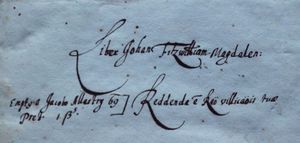Difference between revisions of "John Fitzwilliam d.1699"
| Line 26: | Line 26: | ||
[[Category:Canons]] | [[Category:Canons]] | ||
[[Category:Mottoes]] | [[Category:Mottoes]] | ||
| − | |||
[[Category:Librarians]] | [[Category:Librarians]] | ||
| − | [[Category: | + | [[Category:All Owners]] |
Revision as of 07:19, 21 July 2020
John FITZWILLIAM d.1699
Biographical Note
Born in London. BA Magdalen College, Oxford 1656, MA 1658, fellow 1661, DD 1677; he was noted at the College as an enthusiastic supporter of Laudian ritual in church worship. Chaplain to Thomas Wriothesley, Earl of Southampton 1664, to James Duke of York 1666; rector of Brighstone, Isle of Wight 1669, and subsequently of Cottenham, Cambridgeshire. Canon of St George's Windsor 1688. After James's abdication he refused to swear allegiance to William and Mary so was deprived of his offices; he spent the last decade of his life writing, with some involvement in the political affairs of London non-juring circles, partly supported by his former pupil Rachel, Lady Russell.
Books
Fitzwilliam served as College librarian at Magdalen and on his death he bequeathed to the library there not only the bulk of his personal library, but also an endowment of £500. His papers were left to Thomas Smith and subsequently acquired by Richard Rawlinson, and then the Bodleian Library. Magdalen received some books which are mostly still there today, covering a range of subjects typical of an academic library of the time. Fitzwilliam's books are noteworthy not only for their characteristic inscriptions but also as being, often, in better than average quality bindings; many of his books stand out on the Magdalen shelves with gilded spines, and he evidently spent a little more on his bindings than was necessary for them to be merely serviceable.
Characteristic Markings
Fitzwilliam regularly marked his books on their flyleaves not only with his name and mottoes ("Reddenda e Rao villicaois", "Philosophorum vita est commentatio mortis" – The life of philosophers is the meditation of death), but also with the year of acquisition, and sometimes with the price and bookseller from whom purchased. He also sometimes added "perlegi" notes of his date of reading.
Sources
- Brunton, D. A. "Fitzwilliam, John (d. 1699), nonjuring Church of England clergyman." Oxford Dictionary of National Biography.
- Morgan, P. Oxford libraries outside the Bodleian. 2 nd edn, Oxford, 1980.
